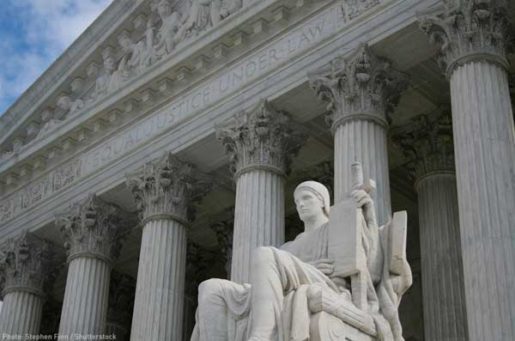by Hooshyar Afsar
Historical and Future Considerations Regarding the Supreme Court of the United States
In all likelihood, by the time you read this article, Judge Amy Coney Barrett will have become Justice Coney Barrett and the conservative wing of the Supreme Court will have gained a 6-3 majority that will be unprecedented going back many decades. The new conservative majority could have a massive impact not only on policy—for example, by overturning the Affordable Care Act (aka Obamacare) as early as November 2020 and later the historic Roe v. Wade decision that legalized abortion in 1973—but on the upcoming presidential election itself. By the time this article is published, we might be in the middle of a contested presidential election that many predict could make the 2000 Bush v. Gore case—in which the Supreme Court effectively gave the presidency to George W. Bush by halting a recount of votes in Florida, where, at the time of the ruling, Bush had a mere 537 vote advantage out of almost six million ballots cast in Florida—look like a cakewalk. In that election, Al Gore ultimately won the overall popular vote by over 440,000 votes.

In light of the pending Supreme Court nomination and November’s presidential election, I want to examine historical aspects of the Supreme Court and differentiate among the Constitution of the United States, legislation enacted by the U.S. Congress, and judicial precedence and tradition.
The U.S. Constitution’s Minimal Description of the Supreme Court
Let’s start by looking at the federal constitution, which was approved at the Constitutional Convention of 1787. The original constitution was ratified by all thirteen founding colonies and was comprised of seven articles; it has since been amended 27 times. The first three articles were dedicated to the three branches of the federal government—namely, legislative, executive, and judiciary, and in that exact order. Of those first three articles, Article III, pertaining to the judicial branch, is the shortest with only three sections.
Article III, Section 1 basically states that judicial power lies in one Supreme Court and in inferior (meaning lower federal) courts as determined by Congress. It then states that the judges (note that it doesn’t even use the term “justices”) of the Supreme Court and the lower courts shall hold their office during good behavior and their salary (compensation) should not be reduced during service. That’s it. Article III does not say anything about the number of justices (or judges) that should comprise the Supreme Court, leaving that decision for Congress to decide.
Nor does Article III say anything about the process of appointing justices. That point is covered in the second clause (paragraph) of Article II, Section 2, which describes the powers of the President to “… nominate, and by and with Advice and Consent of the Senate, shall appoint Ambassadors, other public Ministers and Consuls, Judges of the supreme Court … .” So the appointment of “Judges of the supreme Court” are grouped together with “Ambassadors” and “other public Ministers” with the vague language of “Advice and Consent of the Senate.” That is it when it comes to justices of the Supreme Court as far as the U.S. Constitution is concerned.
Ad Hoc Development of the Process for Appointing Justices to the Supreme Court
So, where did all this process for appointing justices to the Supreme Court come from? The answer is that the process is based on traditions and “gentlemen’s” agreements. As shown above, the language of the Constitution’s Article III only states “Advice and Consent of the Senate.” So, there are no laws or even rules written in the Senate that say how the president chooses new justices and how the Senate confirms them. There are even arguments among constitutional scholars over what exactly “Advice and Consent of the Senate” means.
How Many Justices? That’s Political
As discussed earlier, neither Article III, Section 1, nor any other clause in the entire U.S. Constitution, including all 27 amendments, contains any mention of the number of Supreme Court justices. By omission, the issue was left to Congress to decide and that’s exactly what happened in the Judiciary Act of 1789, approved by the first Congress. Based on that Act, Congress set the number of justices to six, including one chief justice and five associate justices. Then the political dispute of Federalists versus Democratic Republicans caused the outgoing Adams administration and the Federalist majority of Congress to pass the Judiciary Act of 1801, thus decreasing the number of justices to five upon the first vacancy in the Supreme Court. Just to contextualize the politicization of the Supreme Court nominations, the 1801 Act passed 19 days before the second president of the United States, John Adams, left office. So, whoever says that there is a tradition of not politicizing the Supreme Court is selling you snake oil. In fact, after Jefferson took office in 1801, the new Congress—with a Democratic-Republican majority (Jefferson’s party)—repealed the 1801 Act and the 1802 Act provisioned that the number of Supreme Court justices be increased to 7 by 1807.
The roller coaster story of the Supreme Court justices doesn’t end there. In fact, another Act in 1837 increased the number of justices to nine and then President Lincoln and the Republican-dominated Congress passed the Tenth Circuit Act of 1863 that increased the number of justices to ten in the midst of the Civil War just because the president wanted to curb the powers of openly pro-slavery Chief Justice Taney. Obviously, the saga was not over and the 1866 Act again set the number all the way back to seven via vacancies (death, retirement, or impeachment), but before the Supreme Court even got back to seven justices, the Judiciary Act of 1869 restored it back to nine. Even after 1869, there were attempts to change the make-up of the Court. In 1937, FDR had a proposed bill to increase the number of Supreme Court justices to 15 because the Court kept striking down his New Deal legislation. The proposed change was only averted because two of the justices switched to become pro-New Deal and that became known as “the switch in time that saved nine.” So, let there be no mistake, the United States Congress has the constitutional power to change the number of Supreme Court justices and it has done so multiple times in the past. End of story.
Judicial Review—A Judicial Power Grab
Now let’s talk about another very significant function of the Supreme Court and that is the notion of judicial review. This concept basically means that Supreme Court may rule on the constitutionality of a law passed by the United States Congress. Again, neither Article III of the Constitution (remember the shortest of the first three articles) nor any other articles or the 27 amendments provide that power to the Supreme Court. Also, no laws passed by Congress have made judicial review legal.
Why is this important? Because as discussed earlier, by the time you are reading this article, the Supreme Court could be in the process of striking down the Affordable Care Act (aka Obamacare), depriving over twenty million Americans of health care and negatively impacting tens of millions by taking away the pre-existing medical conditions clause of the ACA. According to a September 22, 2020, New York Times article, as many as 133 million Americans have pre-existing medical conditions. COVID-19 has exacerbated this problem significantly since at least 8 million people have tested positive. Add to all this, all the young people under the age of 26 who are covered under their parents’ health plan as provisioned by the ACA will lose their coverage. The number of people of color who will be impacted by probable repeal of the ACA will again be disproportionally high compared to their population size as hundreds of years of racial and economic injustice has put them in the high risk categories including disproportionate numbers of COVID-19 infections. So, where did this beast called judicial review come from if it is not in the U.S. Constitution and it is not in any laws passed by Congress? The short answer: it is based on precedent, which is a fancy term for tradition.
The first three chief justices of the Supreme Court had very short terms until John Marshall was appointed by President John Adams in 1801. Marshall remained chief justice for 34 years until his death in 1835. One of the most significant rulings of the Marshal Court happened in 1803 in Marbury v. Madison that established the principle of judicial review. Yes, that’s correct. Judicial review came into play by a ruling of the Supreme Court, not by any amendments to the U.S. Constitution or any laws passed by Congress. The Court pretty much increased its power by giving itself the authority to strike down one of the provisions of the 1789 Judiciary Act in Marbury v. Madison. Hence, we have a judicial review that allows the Supreme Court to rule on the constitutionality of laws. It is important to add that people who set this precedent were white men born in the eighteenth century. Chief Justice Marshall, who wrote the majority decision in Marbury v. Madison, was a slave owner from the state of Virginia. According to an article in the August 2020 issue of the University of Chicago Law Review by Paul Finkelman, and contrary to many biographies and articles written about the great Chief Justice Marshall, he not only owned hundreds of slaves during his lifetime, but his Court “heard fourteen cases involving black freedom. The Chief Justice wrote the majority opinion in seven, and in every case, the slaves lost.” The article rightfully states that “Chief Justice Marshall never wrote an opinion supporting black freedom.” Why is all this relevant? It is relevant because the precedent of judicial review was invented by a group of white supremacist male justices and a chief justice who was a slave owner—a precedent that is nowhere to be found in the Constitution of the United States and could impact the livelihood and health of tens of millions of Americans in the near future!
Hopefully, by the time this article is published, American democracy will have passed a vital test with a landslide defeat of Donald Trump in the November presidential election and the flipping of the majority in the Senate so that the long-overdue increase in the justices of the Supreme Court can become a reality through an act of Congress. This is a necessity for the expansion of American democracy so that many of the anti-democratic rulings of the Roberts Court can be overturned. Perhaps future generations will write and pass constitutional amendments to make judicial review unconstitutional, change presidential elections to be effectively based on the popular vote, safeguard equal rights for women, and, last but not least, judge discrimination based on race and gender by outcome rather than by intent. That’s an America worth striving for!

















